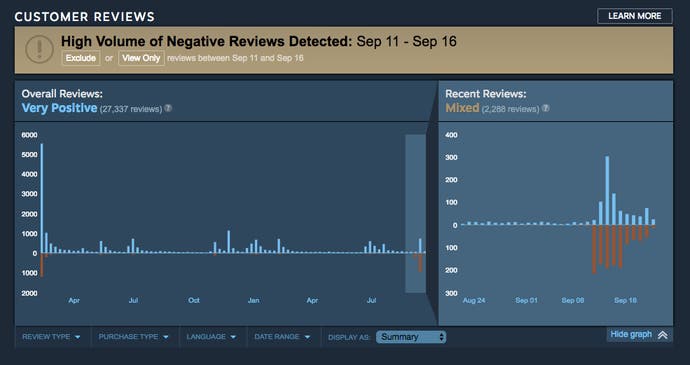Steam counters "review bombing" by adding time graphs to game scores
"See how a game's reviews have evolved over time."
Steam has added a new option to view how a game's user reviews have changed over time as a measure to counter "review bombing".
"Review bombing" is when a mob of users downvote a game for reasons outside of the game itself. Beyond simply slamming the title in question, review bombers will also upvote each other's reviews, while downvoting those who disagree with them.
We saw this most recently in the case of Firewatch after developer Campo Santo issued a DMCA strike against popular YouTuber Felix "PewDiePie" Kjellberg after he used the N-word in a livestream. Some people weren't happy with the developer's tactic in this case, so they decided to take it out by review bombing the game on Steam.
In a lengthy blog post Steam UI designer Alden Kroll explained Valve's thinking in addressing review bombing.

One thing it noticed was that review bombing would often only affect a game's overall score for a short period, as once a controversy would blow over the Review Score would recover back to where it was before.
"When we look at what happens with the Review Score after a review bomb, we see that it generally recovers, in some cases fully back to where it was beforehand," Kroll stated.
"Review bombs make it harder for the Review Score to achieve its goal of accurately representing the likelihood that you'd be happy with your purchase if you bought a game," he added. "We thought it would be good to fix that, if we could do it in a way that didn't stop players from being able to voice their opinions."
While Valve wrestled with the idea of removing an overall Review Score, or temporarily putting a freeze on submitting reviews, or giving reviews less weight in the midst of a review bomb, it ultimately decided that all of these options would too strongly remove players' ability to share their opinions and would result in a less accurate consensus overall.
So instead, Valve decided to not change anything about how the reviews themselves work, but it would offer a "histogram" chart revealing the curve of user reviews over time. This way review bombs would be immediately obvious to shoppers looking for a more long-term understanding of how buyers felt about a game.
"Starting today, each game page now contains a histogram of the positive to negative ratio of reviews over the entire lifetime of the game, and by clicking on any part of the histogram you're able to read a sample of the reviews from that time period," Kroll said.
"As a potential purchaser, it's easy to spot temporary distortions in the reviews, to investigate why that distortion occurred, and decide for yourself whether it's something you care about. This approach has the advantage of never preventing anyone from submitting a review, but does require slightly more effort on the part of potential purchasers."
"It also has the benefit of allowing you to see how a game's reviews have evolved over time, which is great for games that are operating as services," Kroll added, before explaining that most games' scores go down over time as early adopters tend to be the most enthusiastic. "So if you see a game's reviews trending up over time, it may be an even more powerful statement about the quality of work its developers are doing."

















